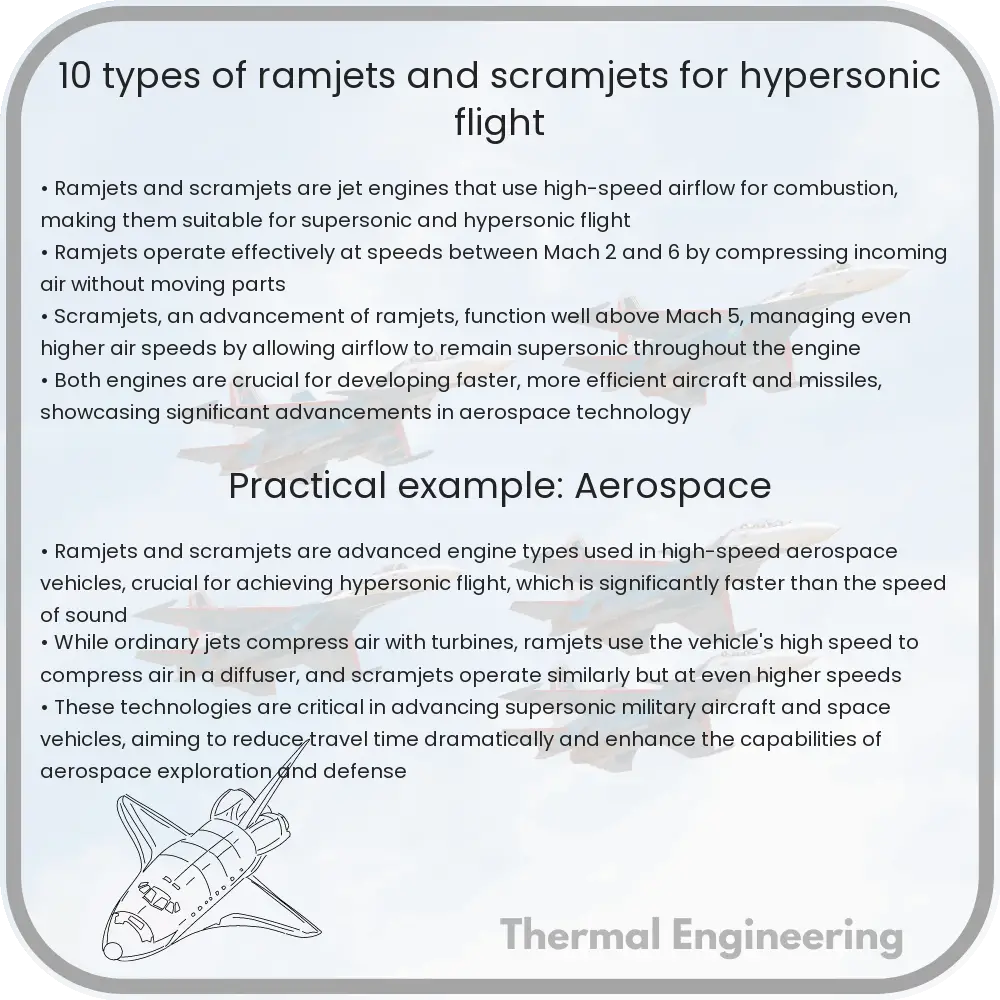Explore the crucial technologies of ramjets and scramjets enabling hypersonic flight at speeds over Mach 5, with insights into advances and applications.

Understanding Ramjets and Scramjets for Hypersonic Flight
Hypersonic flight, typically defined as speeds exceeding Mach 5 (five times the speed of sound), relies heavily on advanced propulsion technologies. Among these, ramjets and scramjets play pivotal roles. These engine types compress incoming air with high vehicle speed rather than mechanical compressors used in traditional jet engines. This article explores various types and advancements in ramjet and scramjet technology that enable sustained hypersonic flight.
Types of Ramjets
- Subsonic Combustion Ramjets: These are traditional ramjets designed to operate efficiently at speeds below Mach 3. They compress air in a subsonic diffuser, making them suitable for moderate-speed applications.
- Supersonic Combustion Ramjets (Scramjets): Extending beyond the capabilities of standard ramjets, scramjets maintain combustion efficiency at higher speeds, from Mach 5 to Mach 15. Unlike ramjets, scramjets allow air to flow through the combustor at supersonic speeds, which is crucial for higher Mach operations.
- Ducted Rockets: Combining elements of rocket and ramjet technologies, ducted rockets carry their oxidizer for independent operation. They switch to external air sources when available, making them versatile for varying flight conditions.
- Variable Cycle Ramjets: These engines transition between turbojet and ramjet operational modes. They are capable of handling lower speeds with turbojet functionality and higher speeds using ramjet mechanics.
Advancements in Scramjet Technology
- Dual-Mode Scramjets: These engines can operate as both ramjets and scramjets, adjusting to different flight phases and speeds. They provide flexibility needed for a broad range of supersonic to hypersonic speeds.
- Hydrogen-Powered Scramjets: Utilizing hydrogen as fuel, these scramjets offer higher specific impulse and efficiency. Hydrogen’s properties facilitate easier ignition and sustained combustion at hypersonic speeds.
- WaveRider Technology: This design leverages shock waves generated by the vehicle to enhance lift and thrust, thereby improving overall flight efficiency and stability at hypersonic speeds.
- Cooled Scramjets: High-speed flight results in intense thermal stresses. Cooled scramjets incorporate active cooling systems to manage and distribute heat, enhancing structural integrity and engine lifespan.
- Multi-Stage Scramjets: These engines feature stages of compression and combustion to incrementally increase airflow velocity to hypersonic speeds within the engine itself, optimizing the combustion process and improving efficiency.
- Intake-optimized Scramjets: The design of the air intake is critical for scramjets, affecting air compression and overall engine performance. Intake-optimized scramjets are tailored for specific flight envelopes to maximize atmospheric oxygen utilization and efficiency.
Impact and Applications
Both ramjets and scramjets represent critical steps towards practical hypersonic travel, promising revolutionary changes in aerospace transportation, including rapid transcontinental flights and enhanced access to space. Military applications include faster and more effective missiles. However, the technological challenges such as material science, thermal management, and fuel efficiency remain substantial and are the focus of ongoing research and development.
Conclusion
Ramjets and scramjets are at the frontier of aerospace engineering, pushing the boundaries of speed and efficiency. As research continues to overcome current limitations, these engines may soon power not only advanced aircraft but also offer new possibilities for space exploration and intercontinental travel.